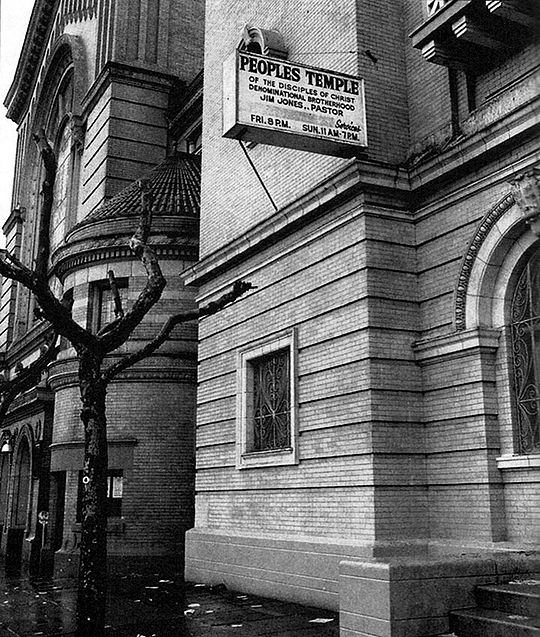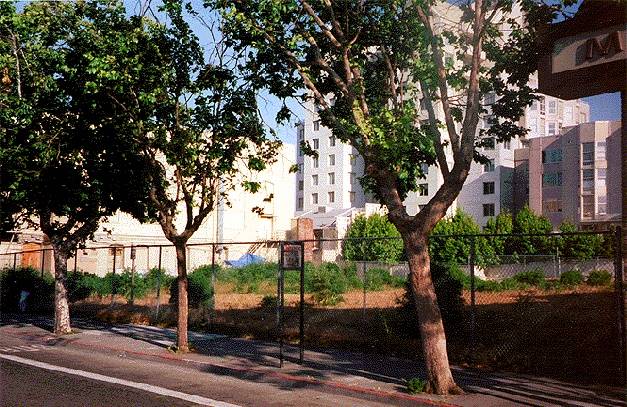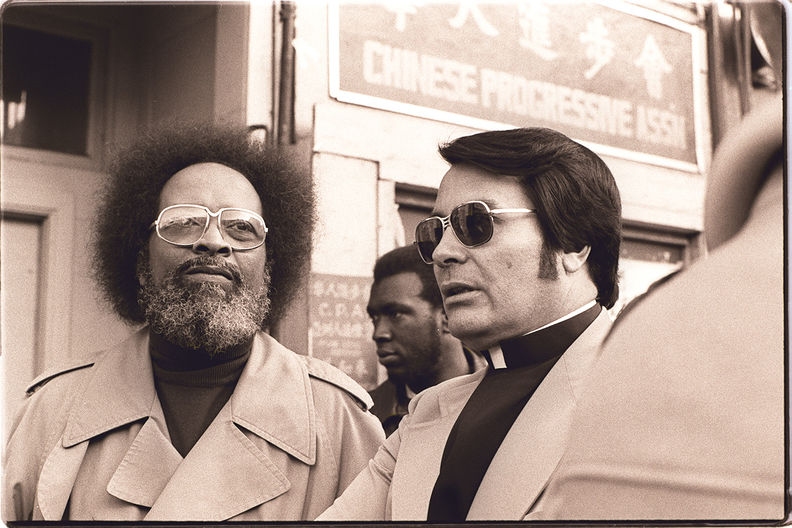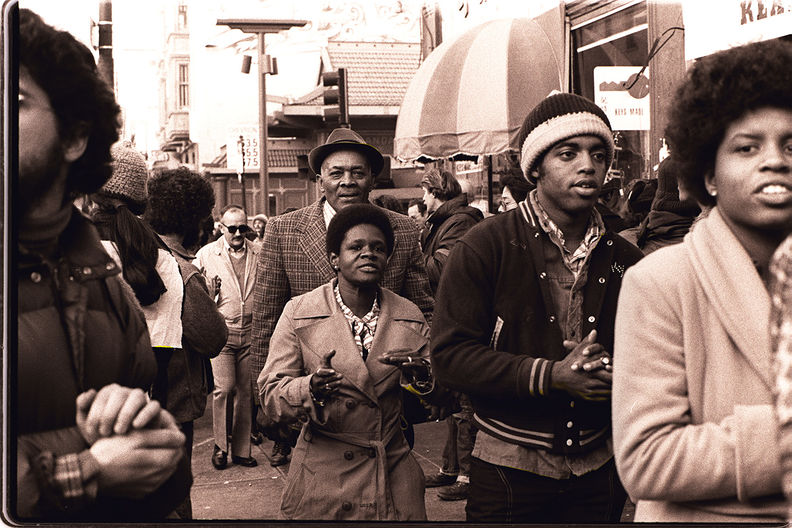Peoples Temple: Difference between revisions
No edit summary |
copied photos from I-Hotel to here |
||
| (5 intermediate revisions by 2 users not shown) | |||
| Line 1: | Line 1: | ||
'''<font face = Papyrus> <font color = maroon> <font size = 4>Historical Essay</font></font> </font>''' | |||
''by Chris Carlsson, with large contributions from Dr. Weirde'' | |||
[[Image:Peoples-temple.jpg|540px]] | |||
'''People's Temple at 1859 Geary in the early 1970s.''' | |||
''Photo: California Historical Society'' | |||
1859 Geary, between Fillmore and Steiner, is the former home of the San Francisco headquarters of the late Reverend Jim Jones and his Peoples Temple. Rev. Jones was the leader of a generally well-respected San Francisco cult who moved his congregation to the South American country of Guyana in 1977, on the eve of the publication of a revealing expose of his authoritarian, drug-addled, sexual abusive practices. A year later, on November 18th, 1978, he coerced 900 followers to commit [[Kool-Aid & Twinkies|mass suicide]] (including many infants and small children who were killed by their parents)—those who resisted were murdered by his security team. | |||
[[Image:westaddi$peoples-temple-site.jpg]] | [[Image:westaddi$peoples-temple-site.jpg]] | ||
'''This vacant lot at 1859 Geary was once the site of | '''This 1996 photo of the vacant lot at 1859 Geary was once the site of Peoples Temple, and is now filled with a modern post office.''' | ||
''Photo: Chris Carlsson'' | ''Photo: Chris Carlsson'' | ||
Jones moved his cult from rural Northern California to San Francisco in the early '70s, where he gradually began to acquire political clout. His beliefs were not all that weird, at least by San Francisco standards; Jones espoused a share-and-share-alike brand of primitive communism based on the gospels, while decrying the greed and materialism of American culture and forging political alliances with leftists. Though his creed was sensible—and far closer to the ideals and practice of Jesus Christ than most American churches ever dream of getting—Jones's personality had a paranoid, authoritarian streak that worsened over the years. He craved absolute love, absolute worship, absolute obedience, and eventually reached the point of insisting upon it, at no matter what price. | |||
During his San Francisco period (the mid-'70s) Jones became a fixture on the local political scene. He sent his followers out as precinct workers for the Moscone for Mayor campaign, and when Moscone eked out a narrow victory, Jones collected his debt by getting himself named Commissioner of Housing. Then, during the 1976 presidential elections, Rosalyn Carter's advance team, hearing that Jones's grassroots organization had made the difference in Moscone's victory, scheduled a meeting between the cult leader and the future First Lady. | |||
In January, 1977, Jones supplied two thousand of the five thousand demonstrators who showed up to protest the evictions of low-income tenants from the International Hotel. And on Memorial Day, 1977, Jones and six hundred followers turned out for a huge anti-suicide demonstration at the Golden Gate Bridge. | |||
[[Image:Cecil Williams and Jim Jones at anti-eviction rally at the I-Hotel, January 1977 Nancy Wong.jpg|792px]] | |||
Jones | '''The reverends Cecil Williams (Glide Church) and Jim Jones (People's Temple) at an anti-eviction rally at the I-Hotel, January 1977.''' | ||
''Photo: Nancy Wong, via Wikimedia Commons'' | |||
[[Image:Members of Peoples Temple attend an anti-eviction rally at the International Hotel, San Francisco - January 1977 Nancy Wong.jpg|792px]] | |||
'''Members of the Peoples' Temple at the anti-eviction rally January 1977.''' | |||
''Photo: Nancy Wong, via Wikimedia Commons'' | |||
At the same time he was developing political clout, Jones was showing signs of the | At the same time he was developing political clout, Jones was showing signs of the insanity that would later claim nearly a thousand lives. As far back as 1973, Jones and his inner circle had developed a fantasy-cum-contingency-plan for mass suicide in case Peoples Temple ever found itself about to be destroyed by its enemies. | ||
In 1975, Jones conducted a bizarre experiment at | In 1975, Jones conducted a bizarre experiment at Peoples Temple headquarters on Geary Street. Jones announced that an excellent wine had been vinted from grapes grown at the Temple's former Redwood Valley headquarters, and that all those present ought to imbibe, despite the Temple prohibition against alcohol. The Reverend circulated among his flock, making sure that all were drinking. Then he called for attention and grimly announced that the wine contained a potent poison; everyone in the room would be dead in less than an hour. By killing themselves en masse, Jones explained, they would be protesting the world's inhumanity. | ||
How did Temple members react? About the same way that citizens usually react when their government declares war. Nobody rebelled; nobody called out for an antidote; nobody stood up and disputed the necessity of mass death. That dress rehearsal had to do, as the song goes, until the real thing comes along. The real thing came along in November | How did Temple members react? About the same way that citizens usually react when their government declares war. Nobody rebelled; nobody called out for an antidote; nobody stood up and disputed the necessity of mass death. That dress rehearsal had to do, as the song goes, until the real thing comes along. The real thing came along in November 1978. Jones and most of his followers had moved to Guyana to escape the greed and corruption of America. They started a communal village, Jonestown, and kept themselves busy growing food and improving the settlement's primitive infrastructure. But their leader was going from weird to worse. Convinced that the U.S. government was plotting against him—and he was probably right, given that any openly pro-communist leader of Jones's persuasive abilities was bound to quickly attract the attention of CIA, FBI, and quasi-official red squads—Jones turned into a full-fledged nut case. | ||
On November | On November 18, 1978, Congressman Leo Ryan led a team of investigators and journalists into Jonestown ... and all hell broke loose. After their disastrous visit, Congressman Ryan and various aides and journalists were mowed down on the airstrip, just before they could board their plane, by Peoples Temple gunmen. (Some, including Tim Reiterman, survived to tell the tale.) | ||
Meanwhile, back in Jonestown, the Reverend Jones was mixing up a huge vat full of purple-hued Grape Flavor Aid spiked with potassium cyanide, and people were getting ready to drink. The whole community had assembled in the central pavilion, surrounded by heavily armed security personnel. No one here gets out alive. The youngest Jonestowners went first; Jones's 12-person medical team shot the potion into the backs of their throats with syringes, and parents and grandparents cried as their children thrashed, screamed, vomited blood, convulsed, and eventually died. Meanwhile, various loyal followers stood up and offered heartfelt tributes to the greatness and wisdom of Jim Jones: | Meanwhile, back in Jonestown, the Reverend Jones was mixing up a huge vat full of purple-hued Grape Flavor Aid spiked with potassium cyanide, and people were getting ready to drink. The whole community had assembled in the central pavilion, surrounded by heavily armed security personnel. No one here gets out alive. The youngest Jonestowners went first; Jones's 12-person medical team shot the potion into the backs of their throats with syringes, and parents and grandparents cried as their children thrashed, screamed, vomited blood, convulsed, and eventually died. Meanwhile, various loyal followers stood up and offered heartfelt tributes to the greatness and wisdom of Jim Jones: | ||
| Line 33: | Line 55: | ||
''We've set an example for others. One thousand people who say: we don't like the way the world is. Take our life from us ... We didn't commit suicide. We committed an act of revolutionary suicide protesting the conditions of an inhumane world.'' | ''We've set an example for others. One thousand people who say: we don't like the way the world is. Take our life from us ... We didn't commit suicide. We committed an act of revolutionary suicide protesting the conditions of an inhumane world.'' | ||
In Julia Scheeres' well-researched book "A Thousand Lives: The Untold Story of Hope, Deception, and Survival at Jonestown," she shows how years of Jones' authoritarian tactics had cowed most of his followers into confused and fearful obedience. A large number of Peoples Temple members were not in favor of suicide and had to be forced by a combination of peer pressure and armed guards into participating in the horrible events of November 1978. | |||
[[Bell Mansion |Prev. Document]] [[Laguna and Fulton 1882 |Next Document]] | [[Bell Mansion |Prev. Document]] [[Laguna and Fulton 1882 |Next Document]] | ||
[[category:Western Addition]] [[category:San Francisco outside the city]] [[category:religion]] [[category:Famous characters]] [[category:1970s]] | [[category:Western Addition]] [[category:San Francisco outside the city]] [[category:religion]] [[category:Famous characters]] [[category:1970s]] [[category:Churches]] | ||
Latest revision as of 21:41, 23 April 2020
Historical Essay
by Chris Carlsson, with large contributions from Dr. Weirde
People's Temple at 1859 Geary in the early 1970s.
Photo: California Historical Society
1859 Geary, between Fillmore and Steiner, is the former home of the San Francisco headquarters of the late Reverend Jim Jones and his Peoples Temple. Rev. Jones was the leader of a generally well-respected San Francisco cult who moved his congregation to the South American country of Guyana in 1977, on the eve of the publication of a revealing expose of his authoritarian, drug-addled, sexual abusive practices. A year later, on November 18th, 1978, he coerced 900 followers to commit mass suicide (including many infants and small children who were killed by their parents)—those who resisted were murdered by his security team.
This 1996 photo of the vacant lot at 1859 Geary was once the site of Peoples Temple, and is now filled with a modern post office.
Photo: Chris Carlsson
Jones moved his cult from rural Northern California to San Francisco in the early '70s, where he gradually began to acquire political clout. His beliefs were not all that weird, at least by San Francisco standards; Jones espoused a share-and-share-alike brand of primitive communism based on the gospels, while decrying the greed and materialism of American culture and forging political alliances with leftists. Though his creed was sensible—and far closer to the ideals and practice of Jesus Christ than most American churches ever dream of getting—Jones's personality had a paranoid, authoritarian streak that worsened over the years. He craved absolute love, absolute worship, absolute obedience, and eventually reached the point of insisting upon it, at no matter what price.
During his San Francisco period (the mid-'70s) Jones became a fixture on the local political scene. He sent his followers out as precinct workers for the Moscone for Mayor campaign, and when Moscone eked out a narrow victory, Jones collected his debt by getting himself named Commissioner of Housing. Then, during the 1976 presidential elections, Rosalyn Carter's advance team, hearing that Jones's grassroots organization had made the difference in Moscone's victory, scheduled a meeting between the cult leader and the future First Lady.
In January, 1977, Jones supplied two thousand of the five thousand demonstrators who showed up to protest the evictions of low-income tenants from the International Hotel. And on Memorial Day, 1977, Jones and six hundred followers turned out for a huge anti-suicide demonstration at the Golden Gate Bridge.
The reverends Cecil Williams (Glide Church) and Jim Jones (People's Temple) at an anti-eviction rally at the I-Hotel, January 1977.
Photo: Nancy Wong, via Wikimedia Commons
Members of the Peoples' Temple at the anti-eviction rally January 1977.
Photo: Nancy Wong, via Wikimedia Commons
At the same time he was developing political clout, Jones was showing signs of the insanity that would later claim nearly a thousand lives. As far back as 1973, Jones and his inner circle had developed a fantasy-cum-contingency-plan for mass suicide in case Peoples Temple ever found itself about to be destroyed by its enemies.
In 1975, Jones conducted a bizarre experiment at Peoples Temple headquarters on Geary Street. Jones announced that an excellent wine had been vinted from grapes grown at the Temple's former Redwood Valley headquarters, and that all those present ought to imbibe, despite the Temple prohibition against alcohol. The Reverend circulated among his flock, making sure that all were drinking. Then he called for attention and grimly announced that the wine contained a potent poison; everyone in the room would be dead in less than an hour. By killing themselves en masse, Jones explained, they would be protesting the world's inhumanity.
How did Temple members react? About the same way that citizens usually react when their government declares war. Nobody rebelled; nobody called out for an antidote; nobody stood up and disputed the necessity of mass death. That dress rehearsal had to do, as the song goes, until the real thing comes along. The real thing came along in November 1978. Jones and most of his followers had moved to Guyana to escape the greed and corruption of America. They started a communal village, Jonestown, and kept themselves busy growing food and improving the settlement's primitive infrastructure. But their leader was going from weird to worse. Convinced that the U.S. government was plotting against him—and he was probably right, given that any openly pro-communist leader of Jones's persuasive abilities was bound to quickly attract the attention of CIA, FBI, and quasi-official red squads—Jones turned into a full-fledged nut case.
On November 18, 1978, Congressman Leo Ryan led a team of investigators and journalists into Jonestown ... and all hell broke loose. After their disastrous visit, Congressman Ryan and various aides and journalists were mowed down on the airstrip, just before they could board their plane, by Peoples Temple gunmen. (Some, including Tim Reiterman, survived to tell the tale.)
Meanwhile, back in Jonestown, the Reverend Jones was mixing up a huge vat full of purple-hued Grape Flavor Aid spiked with potassium cyanide, and people were getting ready to drink. The whole community had assembled in the central pavilion, surrounded by heavily armed security personnel. No one here gets out alive. The youngest Jonestowners went first; Jones's 12-person medical team shot the potion into the backs of their throats with syringes, and parents and grandparents cried as their children thrashed, screamed, vomited blood, convulsed, and eventually died. Meanwhile, various loyal followers stood up and offered heartfelt tributes to the greatness and wisdom of Jim Jones:
I'd like to thank Dad because he's the only one who stood up for me.
This is nothing to cry about, this is something we could all rejoice about ... Jim Jones has suffered and suffered ... He is our only God.
I'd like to go for socialism and communism. I thank Dad very much.
Just before the reel-to-reel tape that recorded these and other testimonials ran out, Jones himself said:
We've set an example for others. One thousand people who say: we don't like the way the world is. Take our life from us ... We didn't commit suicide. We committed an act of revolutionary suicide protesting the conditions of an inhumane world.
In Julia Scheeres' well-researched book "A Thousand Lives: The Untold Story of Hope, Deception, and Survival at Jonestown," she shows how years of Jones' authoritarian tactics had cowed most of his followers into confused and fearful obedience. A large number of Peoples Temple members were not in favor of suicide and had to be forced by a combination of peer pressure and armed guards into participating in the horrible events of November 1978.




